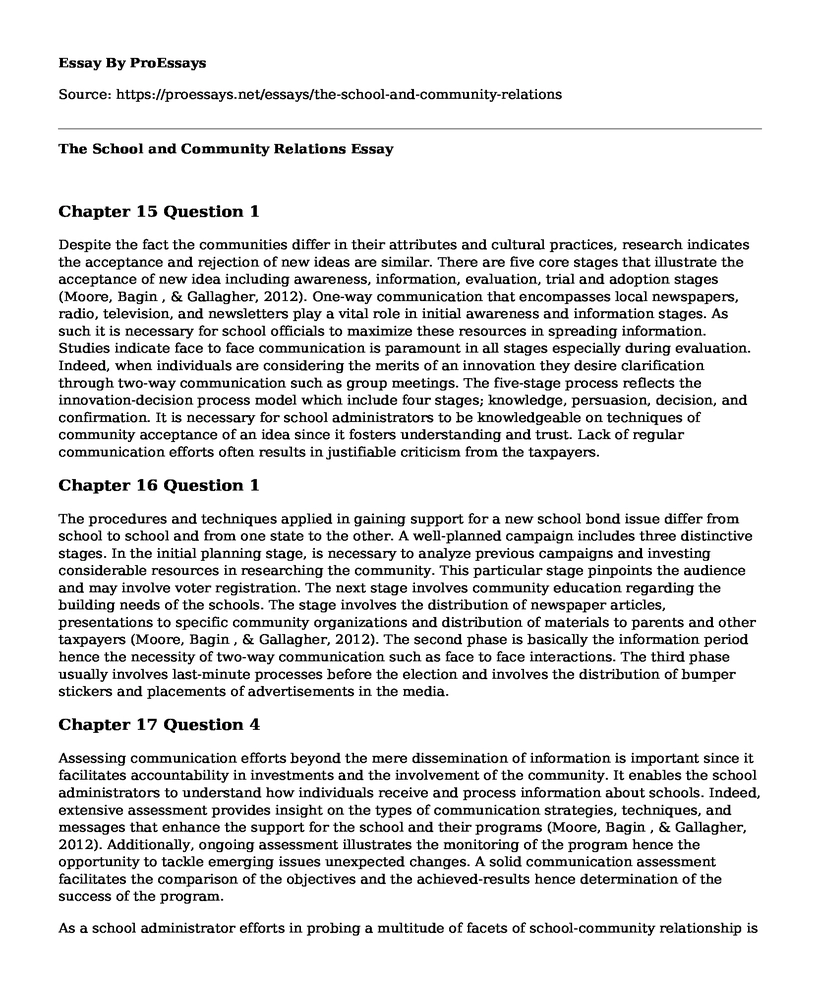Chapter 15 Question 1
Despite the fact the communities differ in their attributes and cultural practices, research indicates the acceptance and rejection of new ideas are similar. There are five core stages that illustrate the acceptance of new idea including awareness, information, evaluation, trial and adoption stages (Moore, Bagin , & Gallagher, 2012). One-way communication that encompasses local newspapers, radio, television, and newsletters play a vital role in initial awareness and information stages. As such it is necessary for school officials to maximize these resources in spreading information. Studies indicate face to face communication is paramount in all stages especially during evaluation. Indeed, when individuals are considering the merits of an innovation they desire clarification through two-way communication such as group meetings. The five-stage process reflects the innovation-decision process model which include four stages; knowledge, persuasion, decision, and confirmation. It is necessary for school administrators to be knowledgeable on techniques of community acceptance of an idea since it fosters understanding and trust. Lack of regular communication efforts often results in justifiable criticism from the taxpayers.
Chapter 16 Question 1
The procedures and techniques applied in gaining support for a new school bond issue differ from school to school and from one state to the other. A well-planned campaign includes three distinctive stages. In the initial planning stage, is necessary to analyze previous campaigns and investing considerable resources in researching the community. This particular stage pinpoints the audience and may involve voter registration. The next stage involves community education regarding the building needs of the schools. The stage involves the distribution of newspaper articles, presentations to specific community organizations and distribution of materials to parents and other taxpayers (Moore, Bagin , & Gallagher, 2012). The second phase is basically the information period hence the necessity of two-way communication such as face to face interactions. The third phase usually involves last-minute processes before the election and involves the distribution of bumper stickers and placements of advertisements in the media.
Chapter 17 Question 4
Assessing communication efforts beyond the mere dissemination of information is important since it facilitates accountability in investments and the involvement of the community. It enables the school administrators to understand how individuals receive and process information about schools. Indeed, extensive assessment provides insight on the types of communication strategies, techniques, and messages that enhance the support for the school and their programs (Moore, Bagin , & Gallagher, 2012). Additionally, ongoing assessment illustrates the monitoring of the program hence the opportunity to tackle emerging issues unexpected changes. A solid communication assessment facilitates the comparison of the objectives and the achieved-results hence determination of the success of the program.
As a school administrator efforts in probing a multitude of facets of school-community relationship is vital in promoting the right of students to quality education. The course, school and community relations has been vital in shaping my understanding my ideas as an administrator. I have learned the interaction of schools the community and the society, in general, involve issues of huge scope and weighty consequences if not addressed effectively. I acknowledge school systems vary individually and in different states so do the communities. Indeed, the course has enabled me to discover no snap answers and sure-defined methods are available in the establishment and development of school-community relationships. The course has demonstrated the growing urgency of the extensive involvement of the community in school programs from the curriculum, extra-curriculum activities and the costs involved in the provision of quality education. Additionally, the course has challenged me to be open to the delegation as an administrator including hiring consultants in areas that require wide involvement. Above everything, I have learned the value of communication assessment in increasing accountability both in investment and involvement of the community and the society in general in school programs.
SWOT Analysis
Strengths
Extensive communication skills that are the epitome of public relations. As an administrator, interactions with others is the core of initiating and advancing relationships.
I am knowledgeable and sensitive to the diversity of the society hence keen on making decisions that are culture-sensitive.
Leadership-oriented hence the ability to oversee certain projects regarding school-community relations.
I tend to adapt to situations since I understand situations change and developing consistent and effective relationships it is necessary to access situations quickly and change with them.
Weakness
I am poor at handling stress which is inevitable in the dynamic school-community relationship. Initiating, establishing and developing relationships is often stressful.
Difficulty in delegating. I am often overcome with the need to be all things to all people which I have realized would be difficult in efforts to develop extensive school-community relations.
Opportunities
The consistent advancement in communication technology in the past two decades illustrate the potential of information technology expanding hence facilitating deep and wide information that improves school-community relations.
Improvement in school-community relations continues to garner attention in every state especially the taxpayers in efforts of improving the quality of education.
Threats
The high regard many educators and their colleagues hold minimize the value of outside of opinion hence reducing the impact of school-community relations.
Reference
Moore, E. H., Bagin , D., & Gallagher, D. R. (2012). The School and Community Relations. Pearson.
Cite this page
The School and Community Relations . (2022, Apr 04). Retrieved from https://proessays.net/essays/the-school-and-community-relations
If you are the original author of this essay and no longer wish to have it published on the ProEssays website, please click below to request its removal:
- Research Paper on Academic Excellence of the African Americans Studying in the USA
- Essay on Security Awareness Communication Methods
- One Moment That Completely Changed My Life Essay
- Essay Example on Standardizing Language: Achieving Uniformity in Communication
- Silent Reading: Exploring Its Effects on the Brain - Research Paper
- Speech Example on The Incredible Life of Arnold Schwarzenegger
- Report Sample on Mass Communication on Marginalized Groups







